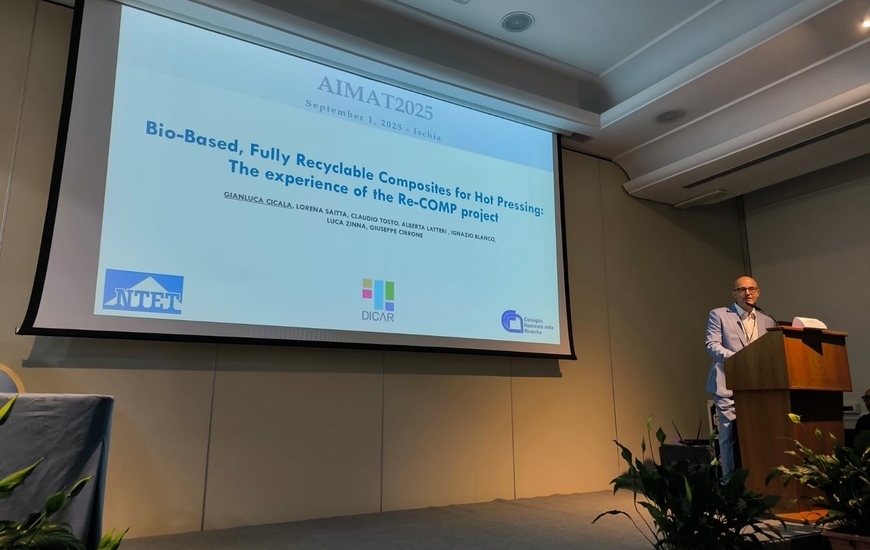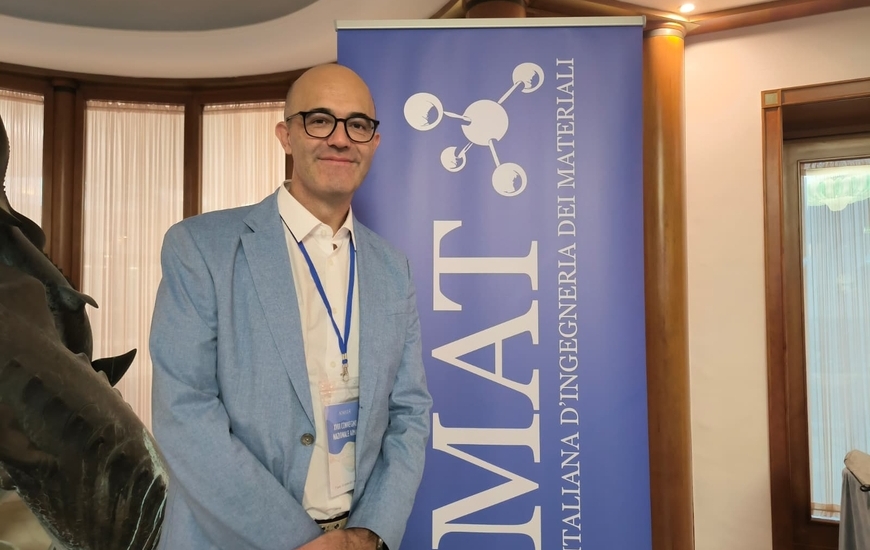by NICOLA CATENARO
From strengthening the Italian scientific community to exploring the potential of biocomposites, and highlighting the crucial role of multidisciplinary research: the new president of AIMAT (Italian Association of Materials Engineering), professor Gianluca Cicala (professor of Materials Science and Technology and deputy director of DICAR at the University of Catania, Italy), outlines his vision for a future where materials engineering, sustainability, and technology transfer intertwine to meet the challenges of industry and society.
Professor Cicala, what are your priorities as the new president of AIMAT?
“Certainly, among the main priorities will be strengthening AIMAT’s communication activities and, secondly, enhancing the use of some resources already available within AIMAT aimed at spreading knowledge about materials engineering, also through joint research initiatives. I am convinced that the AIMAT community has a knowledge and data base that, if further rationalized and systematized, could have a significant impact on technical progress in various sectors.”
What are the most interesting prospects in research on new materials?
“There are several promising directions, as highlighted at the last AIMAT national congress held in Ischia from August 31 to September 3. The congress brought together 220 participants with around 300 oral and poster presentations. It opened with an engaging plenary lecture by Professor Teodoro Valente, former AIMAT president and current president of the Italian Space Agency, on the future of space exploration, followed by a talk from Professor Edoardo Bemporad, AIMAT board member and current director of CNR-ICPB, on materials research in Europe. I mention these two talks because, in my view, they both emphasized how the complexity of materials research now requires multidisciplinary approaches, combining vertical and horizontal expertise, and a critical mass of interacting researchers. For instance, the need to develop multifunctional new materials—those with multiple specific properties allowing them to perform several functions—appears to be a strategic challenge. In this area, we can cite self-healing materials, or those capable of generating or storing energy, or detecting parameters such as temperature or stress state, etc. The congress also showed how even more traditional materials and applications can benefit from innovative approaches developed in other contexts. For example, Professor Valeria Daniele presented how the conservation of historic wooden artifacts can now be addressed using magnesium hydroxide-based nanomaterials, which are otherwise applied as antibacterial or flame-retardant agents. Equally important were several presentations underlining the development of new low-environmental-impact materials. This approach entails a radical paradigm shift in conceiving materials, with design that includes the phases of production, use, recycling, and reuse. The last phase, for some materials, can be particularly challenging. Take, for instance, battery materials that must not only store large amounts of energy but also be easily recyclable and reusable at the end of their life cycle. This is especially critical for rare-earth-based materials, given the looming risk of global resource shortages. Within this framework, the development of biocomposites also offers very interesting opportunities.”
In your view, what are the main opportunities that biocomposites offer for the transition toward a more sustainable and circular economy?
“If by biocomposites we mean materials produced from renewable sources and that, at the end of their life, can either be fully reused or perfectly recycled in the environment without harm, we are clearly talking about the Holy Grail of materials. In this perspective, and limited to one class of composite materials, I have presented some results from research my group Polymers and Composites has been carrying out. In this case, the key lies in identifying epoxy-based thermoset chemistry as a potential solution to the recyclability problem. Once cured, thermosets are stable and non-degradable. However, some of our studies have shown that a careful selection of chemical groups within the structure makes the material degradable under controlled conditions, yielding simple-structure materials that can be directly reused in the same production cycle. I called it the Holy Grail because, although the results are promising, achieving products entirely from renewable sources remains difficult, since natural materials do not always have the required thermomechanical properties, limiting their applicability.”
Which industrial sectors (aerospace, automotive, construction, biomedical, etc.) are showing the greatest interest and potential in adopting biocomposites?
“Potentially, all the sectors you mentioned are interested in biocomposites. However, it’s important to note that in some areas there are technical and regulatory hurdles that are hard to overcome. For instance, in aerospace, stringent thermomechanical and regulatory requirements make it difficult to envision biocomposites being used in primary structures. That said, specific applications could benefit from their unique features. To give one example, in aerospace structures designed for atmospheric operation, materials with controlled degradation could help address the issue of space debris. Looking at other applications, automotive interiors have been using natural fiber-reinforced composites for years, so the use of biocomposites there is well established and extendable to other sectors. In construction, if we consider biocomposites as materials derived directly from natural substances or processes, there is definitely great momentum, and the catalogs of major companies already feature established products.”
What are the main technical challenges still to be overcome to make biocomposites competitive with traditional materials?
“In my opinion, several limitations remain, mostly linked to certain material specifics. If we consider matrices derived from renewable natural sources, such as vegetable oils, a major issue is the actual availability of massive quantities and the stability of the product itself. For years, the industry has relied on refinery-based products with production cycles unaffected by environmental conditions. When starting materials come from plants, scaling up production sometimes competes with the food sector or is constrained by actual crop availability. This is why recent calls for BBI funding (https://www.cbe.europa.eu) have explicitly required research projects not to use food-cycle products. For example, deriving thermoset matrices from soy impacts a key staple in many food systems, and it is certainly undesirable to alter its price and availability. Additionally, there are often technical constraints, such as the thermomechanical properties of natural materials, that limit the replacement of refinery-based materials. That said, there are encouraging developments: for instance, ‘green epichlorohydrin’ (https://epinitychem.com) can be combined with natural bisphenols to produce fully green epoxy resins with controlled properties.”
How can AIMAT support the transfer of innovations from research labs to real industrial applications?
“AIMAT is a complex organization with over 200 researchers from universities across Italy. This creates a broad and comprehensive set of skills in materials engineering. Already today, our researchers work closely with national and international companies, supporting them in developing materials and related technologies. By statute, AIMAT must promote both the teaching of materials science and engineering and the collaboration between research and associations. Therefore, AIMAT can certainly serve as a sounding board for initiatives and innovations developed by its members.”
What skills do you consider essential for training the next generation of engineers and researchers?
“On this point, I want to highlight the excellent work carried out by the past-president, Professor MariaPia Pedeferri, and the outgoing board, both in mapping the distribution of courses in Materials Science and Technology taught by IMAT-01/A faculty, and—most importantly—in engaging with the Ministry of Universities (MUR) to define the field’s official description and to establish the master’s degree class Materials Science and Engineering (LM-53). This important achievement provides the new board with a solid data base for evaluating future actions. Among upcoming proposals will be consolidating fundamental skills while also updating cross-disciplinary skills, such as the use of artificial intelligence in materials research and development. In this context, I am pleased to mention the 2024 AIMAT Summer School titled Material Intelligence: from Smart Materials to Artificial Intelligence, organized by Professors Pedeferri and Tirillò. The school clearly highlighted the major role AI already plays—and will increasingly play—in materials science and engineering. Thus, I can say AIMAT is highly active both in consolidating foundational teaching and in promoting innovative education.”
-

-
25 September 2025























